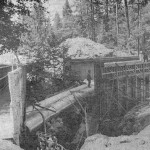The Mountain Area Safety Taskforce devoted its primary focus during its quarterly meeting to the threat to local forests of the Goldspotted oak borer.
Third District Supervisor Jeff Stone included the oak borer in an ongoing emergency declaration originally enacted for the bark beetle in 2002. He placed the issue on the Tuesday, Dec. 18, board of supervisors’ agenda. While the bark beetle problem was confined to the Hill, Stone’s Chief of Staff Verne Lauritzen stressed that the other four supervisors must be educated on the damage the pest could do if it escapes the Third District.
The Goldspotted oak borer was first discovered last month in Idyllwild. At least one tree and some firewood that had been imported from San Diego County confirmed the presence of the destructive beetle on the Hill. While only one tree has been positively identified, officials and scientists urged the MAST group to use the winter and early spring to prepare for possible further outbreaks in warmer months.
“We’re monitoring the sites more intensely this year,” said Dr. Tom Coleman, Forest Service entomologist. Coleman, lead GSOB scientist, was the first to identify the beetle in 2008 as the cause of the oak die-off in San Diego County. He said of the recent discovery in Idyllwild, “We believe the population in Idyllwild is fairly isolated at this time. We haven’t seen anything else at eye level [GSOB infestation is most evident from tree base to 10 feet up the trunk]. And we haven’t picked anything up in traps we’ve set.” But Coleman acknowledged there are no current treatments that can prevent tree die off once infection is confirmed.
Former Hill CAL FIRE Division Chief Kevin Turner is the GSOB program coordinator at UC Cooperative Extension Service at University of California, Riverside. “One thing the San Jacinto Mountains have in MAST is a key player,” he said, while imploring the multiagency leadership to get involved and be prepared. “You’ll be the test case for rapid response. We don’t know if this one tree ends it. At this point, we’ve got to act decisively. Now that it’s here it could be in many more trees. You must begin to think how you are going to be involved. If you [MAST and area volunteers] are successful, you’ll be the model for other counties.”
San Diego County is the current locus of primary GSOB infestation. The beetles have killed 90,000 black, canyon live and coastal live oaks since 2002. More than $8 million in public and private funds has already been spent on GSOB mitigation activities, including dead tree removals, disposing of infested wood and closure of parks and campgrounds due to dead and hazardous trees.
CAL FIRE Forest Battalion Chief Gregg Bratcher, current MAST chair, said the recent discovery of the beetle in Idyllwild has lent a new urgency to the tasks and agenda of this working group. In the past, MAST has successfully focused on measures to prevent catastrophic wildfires — tree removal as part of the bark beetle emergency and thinning of the forests and creation of fuel breaks. Bratcher noted that the oak borer has the potential to run a destructive path north through California to the Pacific Northwest. “Now where do we go from here?” he asked in beginning the discussion of a coordinated multiagency approach.
The MAST group then began developing an action plan to prepare and address the situation in case GSOB has established a wider base on the Hill. Areas covered in the plan include regulatory options — which sworn officers have authority to stop transit of firewood under an existing California penal code; management of transit of firewood into federal, state and county parks; survey, detection and monitoring for oak borer insects in trees and firewood, including training of professional and volunteer groups; outbreak containment; infested tree removal, and public education including mass mailings to mountain residents.
One of the issues Turner addressed was the disposition of infested wood if Goldspotted oak borer has an established population here. As Turner said, “We can ship only so many trees to San Diego County.”
The concern is how to keep the pest isolated on the Hill before it spreads throughout the county. “Isn’t there also a risk of spreading the borer into any oak area in Riverside County if firewood is transported there?” asked Riverside County Fire Chief John Hawkins.
Although it is winter and the oak trees are not showing any symptoms, Scott and others noted that adequate tracking and investigation of beetle spread requires many trained spotters on the ground. “We’re blind right now,” Scott said. “We can’t do much from the air until the leaves are out,” He said. “That means we’ve got to get more [on the ground] information. We need cradle-to-grave documentation of firewood.”
Firewood is the principal means for oak borer to travel and infect new areas. Lauritzen stressed that the public has to be more vigilant demanding to know the source of oak firewood. And Scott raised the idea of possible state legislation.
In order to develop a core of trained GSOB spotters, MAST plans two training sessions for official personnel and key volunteer groups in January. Training will focus on identifying signs of infestation in local oaks, bark and firewood.
A public education meeting for Hill residents to learn about Goldspotted oak borer infestation signs, how to have their oaks checked, and recommendations about firewood purchases and current transportation regulations is scheduled from 2 to 4 p.m. on Saturday, Jan. 19, at Town Hall. Idyllwild residents and property owners are urged to attend.
Planners selected a weekend afternoon to give part-time homeowners, many of whom are from San Diego, an opportunity to attend. Loss of Hill oak stands, on the scale that San Diego County experienced, could severely diminish property values. Cost to remove single infested oaks can range from $750 to $10,000 depending upon proximity to residential structures, campgrounds and schools.









